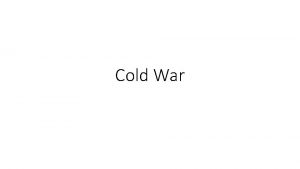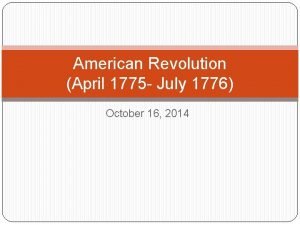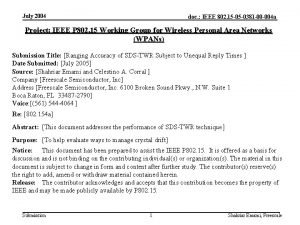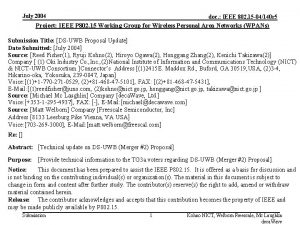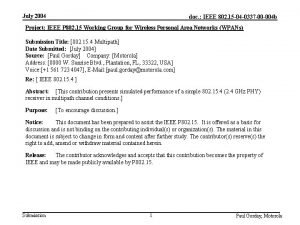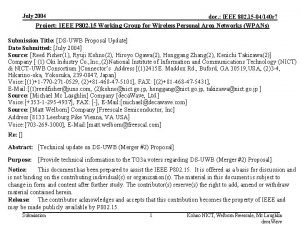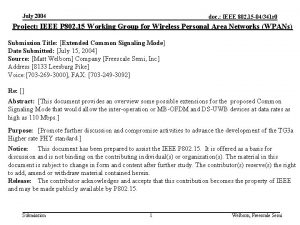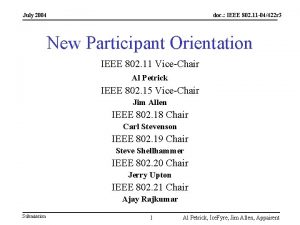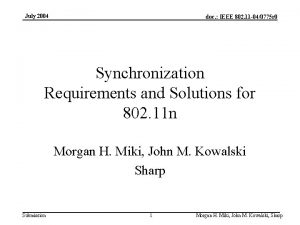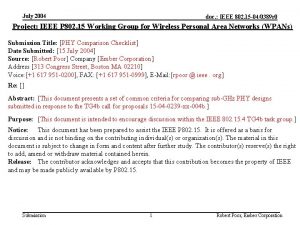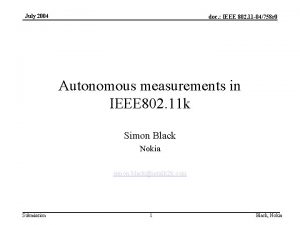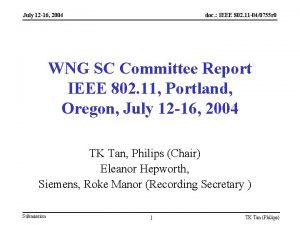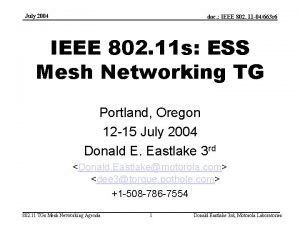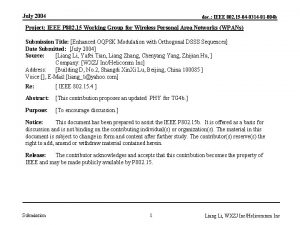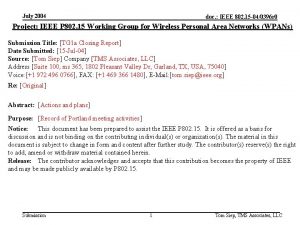July 2004 doc IEEE 802 15 04382 r


























- Slides: 26

July 2004 doc. : IEEE 802. 15 -04/382 -r 1 Project: IEEE P 802. 15 Working Group for Wireless Personal Area Networks (WPANs) Submission Title: [Bi-Directional CTA] Date Submitted: [July 14, 2004] Source: [Mark E. Schrader] Company [Appairent Technologies Inc. ] Address [150 Lucius Gordon Dr. , Suite 211, West Henrietta, NY 14586] Voice: [+01 -585 -214 -0584], FAX: [+01 -585 -214 -2461], E-Mail: [schrader@appairent. com] [Tony Tintera] Company [Appairent Technologies Inc. ] Voice: [+01 -585 -214 -0580], FAX: [+01 -585 -214 -2461], E-Mail: [tintera@appairent. com] [George G. She] Company [Appairent Technologies Inc. ] Voice: [+01 -585 -214 -2467], FAX: [+01 -585 -214 -2461], E-Mail: [she@appairent. com] Re: [] Abstract: [CTA with round robin access and source device provided time slot proprotions for a pair of devices in an IEEE 802. 15. 3 b WPAN] Purpose: [For discussion to support Bi-directional CTA for IEEE 802. 15. 3 b WPAN] Notice: This document has been prepared to assist the IEEE P 802. 15. It is offered as a basis for discussion and is not binding on the contributing individual(s) or organization(s). The material in this document is subject to change in form and content after further study. The contributor(s) reserve(s) the right to add, amend or withdraw material contained herein. Release: The contributor acknowledges and accepts that this contribution becomes the property of IEEE and may be made publicly available by P 802. 15. Submission 1 Mark E. Schrader, Appairent Technologies Inc.

July 2004 doc. : IEEE 802. 15 -04/382 -r 1 Bi-directional CTA July 2004 Submission 2 Mark E. Schrader, Appairent Technologies Inc.

July 2004 doc. : IEEE 802. 15 -04/382 -r 1 Symmetry Problem The Hall proposal provides the ability for the destination device to reply within a certain duration. However, since the 'grant' of this ability is currently tied to the transmission of data by the transmitter, if the transmitter stops sending data, there is no additional granting of reverse transmission time to the destination that may be required to get the transmitter to provide new data. As such, the end part of a CTA may be underutilized in that the transmitter will be 'out' of data, and thus not triggering additional reverse transmission grants (empty packets, etc) nor will the destination have capability to transmit to the sender because it lacks a grant by the transmitting device. This proposal contains a mechanism by which the destination will be provided transmit opportunities regardless of source transmissions. Submission 3 Mark E. Schrader, Appairent Technologies Inc.

July 2004 doc. : IEEE 802. 15 -04/382 -r 1 Overview • We propose extending the use of current CTAs to support bi-directionality using the Hall proposal as the foundation and making several additions. • The resultant scheme has the following properties: – First transmit opportunity by Src DEV – Second transmit opportunity by Dest DEV – Alternating opportunities by source and destination DEVs for the duration of the CTA. – Src Dev specifies maximum size for Src DEV time slots and Dest DEV time slots within the CTA. Submission 4 Mark E. Schrader, Appairent Technologies Inc.

July 2004 doc. : IEEE 802. 15 -04/382 -r 1 Design Criteria • • Different application spaces will require different restrictions of the fraction of a CTA that the Src DEV and Dest DEV are allowed to consume per access. Only one of the two devices may have data to send during the CTA, or part of the CTA. This should be supported to provide good channel utilization, low latency, and high throughput. A DEV may not have data ready to transmit during in a specific “access opportunity” within the CTA, and may have data ready for transmission later in the CTA. Access opportunities should be maximized to allow devices to transmit when they are ready. A master-slave relationship between the Src DEV and Dest DEV is not appropriate for all application spaces. Submission 5 Mark E. Schrader, Appairent Technologies Inc.

July 2004 doc. : IEEE 802. 15 -04/382 -r 1 Reversal Methods • There are two alternative methods: 1. Implicit reversal based on no transmission and CCA if a device does not transmit during its access window (TAW) time. 2. Token passing transmission to reverse control for every access opportunity in the CTA. A device either transmits data or it transmits a token to hand off the transmit opportunity (more details to follow). Submission 6 Mark E. Schrader, Appairent Technologies Inc.

July 2004 doc. : IEEE 802. 15 -04/382 -r 1 Definitions for Scenario Slides • t. S = A variable amount of time that is less than or equal to the amount of time per transmission specified by STF. (What the Src DEV needs up to the max allowed) • t. D = A variable amount of time that is less than or equal to the amount of time per transmission specified by DTF. (What the Dest DEV needs up to the max allowed) • TCTA = The total amount of time in the CTA assigned to the Src DEV by the PNC Submission 7 Mark E. Schrader, Appairent Technologies Inc.

July 2004 doc. : IEEE 802. 15 -04/382 -r 1 CCA Based Reversal 802. 15. 3 Changes and Transmission Scenarios Submission 8 Mark E. Schrader, Appairent Technologies Inc.

July 2004 doc. : IEEE 802. 15 -04/382 -r 1 Dividing Up CTA Time The source must be able to tell the destination how much channel time that it can use during its transmission opportunities. With the CCA method this is done once in the channel time allocation request command Submission 9 Mark E. Schrader, Appairent Technologies Inc.

July 2004 doc. : IEEE 802. 15 -04/382 -r 1 CCA Based Reversal 802. 15. 3 Changes and Transmission Scenarios Submission 10 Mark E. Schrader, Appairent Technologies Inc.

July 2004 doc. : IEEE 802. 15 -04/382 -r 1 Proposed Frame Format Additions • 7. 5. 6. 1 Channel time request command format: add 1 octet to specify the maximum fraction of the allocated channel time that can be used per access by the Dest DEV, the value N such that the fraction is N / 256. • Call this 1 octet field the destination time fraction (DTF). • The PNC repeats this value in the response command (section 7. 5. 6. 2) and in the CTA status IE in the beacon (section 7. 10. 4) through the addition of the DTF field in each of those frame formats. • A DTF value of ‘ 0’ means “Unidirectional time slot”. Submission 11 Mark E. Schrader, Appairent Technologies Inc.

July 2004 doc. : IEEE 802. 15 -04/382 -r 1 Time Fractions • The addition of the DTF field does not change the function of the PNC in allocating channel time. • The DTF field is used to tell the Dest DEV the maximum channel time that it may use for transmitting data each time that it is allowed to transmit in the CTA. • The source time fraction is: STF = 1 – DTF, the maximum channel time that the Src DEV may use for each of its allowed transmissions in the CTA. • The channel time request command can also be used to by the source to modify the DTF assignment. Submission 12 Mark E. Schrader, Appairent Technologies Inc.

July 2004 doc. : IEEE 802. 15 -04/382 -r 1 CCA Transmission Scenarios Submission 13 Mark E. Schrader, Appairent Technologies Inc.

July 2004 Submission doc. : IEEE 802. 15 -04/382 -r 1 14 Mark E. Schrader, Appairent Technologies Inc.

July 2004 Submission doc. : IEEE 802. 15 -04/382 -r 1 15 Mark E. Schrader, Appairent Technologies Inc.

July 2004 Submission doc. : IEEE 802. 15 -04/382 -r 1 16 Mark E. Schrader, Appairent Technologies Inc.

July 2004 doc. : IEEE 802. 15 -04/382 -r 1 Token Passing Based Reversal 802. 15. 3 Changes and Transmission Scenarios Submission 17 Mark E. Schrader, Appairent Technologies Inc.

July 2004 doc. : IEEE 802. 15 -04/382 -r 1 Differences from CCA • No need to modify the channel time request command, etc. , to include the DTF field • Instead, a maximum Dest DEV time slot size is communicated in a the token sent by the Src DEV, which enables the Dest DEV to access to the CTA • Reversal is based on the presence of a known message, not the absence of all messages • Timing of access windows less critical since it is supplemented by the receipt of a message Submission 18 Mark E. Schrader, Appairent Technologies Inc.

July 2004 Submission doc. : IEEE 802. 15 -04/382 -r 1 19 Mark E. Schrader, Appairent Technologies Inc.

July 2004 doc. : IEEE 802. 15 -04/382 -r 1 Source DEV Tokens • • • The token sent from the Src DEV to the Dest DEV (STK) contains size of the Dest DEVs time slot for data transmission This allows the Src DEV to control the amount of the time that it relinquishes to the Dest DEV on a time slot by time slot basis This could be useful for some control applications such as one in which the Dest DEV responds to Srd DEV requests for either status information or streaming image data Submission 20 Mark E. Schrader, Appairent Technologies Inc.

July 2004 doc. : IEEE 802. 15 -04/382 -r 1 Destination DEV Tokens • The token sent from the Dest Dev to the Src DEV (DTK) does not need any size information • Therefore there are two possible mechanisms: 1. A header bit on the last packet in Dest DEV’s time slot, could be used as the implicit token if Src DEV decides how much of the CTA that it will use for itself (the usual case) 2. A token identical to the Src DEV token could be sent by the Dest DEV. This would make the token mechanism identical in both directions, enabling symmetric bi-directionality • The next two slides compare the two methods Submission 21 Mark E. Schrader, Appairent Technologies Inc.

July 2004 Submission doc. : IEEE 802. 15 -04/382 -r 1 22 Mark E. Schrader, Appairent Technologies Inc.

July 2004 Submission doc. : IEEE 802. 15 -04/382 -r 1 23 Mark E. Schrader, Appairent Technologies Inc.

July 2004 doc. : IEEE 802. 15 -04/382 -r 1 Summary and Conclusions Submission 24 Mark E. Schrader, Appairent Technologies Inc.

July 2004 doc. : IEEE 802. 15 -04/382 -r 1 Design Alternatives 1. Reversal mechanism: Access window (CCA) 2. Reversal mechanism: Token Passing a. Token message from Src to Dest, and implicit token from Dest to Src using a header bit. b. Token messages from Src to Dest and Dest to Src for fully symmetric operation Submission 25 Mark E. Schrader, Appairent Technologies Inc.

July 2004 doc. : IEEE 802. 15 -04/382 -r 1 Summary of Overall Advantages • Controlled source and destination time slot sizes manage access for various applications. Can be equal access to very unequal access • High channel utilization • Maximum number of transmit opportunities per CTA • Src DEV still has priority to transmit in the CTA Submission 26 Mark E. Schrader, Appairent Technologies Inc.
 Bridges from 802.x to 802.y
Bridges from 802.x to 802.y Bridges from 802.x to 802.y
Bridges from 802.x to 802.y Wlan standards
Wlan standards Arquitetura ieee 802
Arquitetura ieee 802 Estandar ieee 802
Estandar ieee 802 Ieee 802 standard
Ieee 802 standard Ieee 802 bluetooth
Ieee 802 bluetooth 802 ieee
802 ieee Ieee 802
Ieee 802 Ieee 802 family
Ieee 802 family Ieee 802 3 compliance
Ieee 802 3 compliance July 26 1953
July 26 1953 July 12 1776
July 12 1776 Harris burdick pictures missing in venice
Harris burdick pictures missing in venice July 10 1856
July 10 1856 2003 july 17
2003 july 17 July 14 1789
July 14 1789 Monday 13th july
Monday 13th july June too soon july stand by
June too soon july stand by Poppies in july aoifes notes
Poppies in july aoifes notes July 16 1776
July 16 1776 July 1-4 1863
July 1-4 1863 Sensory language definition
Sensory language definition Ctdssmap payment schedule july 2021
Ctdssmap payment schedule july 2021 July 30 2009 nasa
July 30 2009 nasa Malaga in july
Malaga in july On july 18 2001 a train carrying hazardous chemicals
On july 18 2001 a train carrying hazardous chemicals











